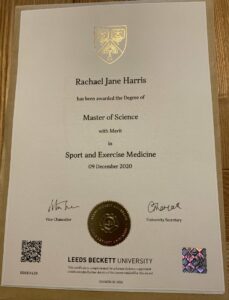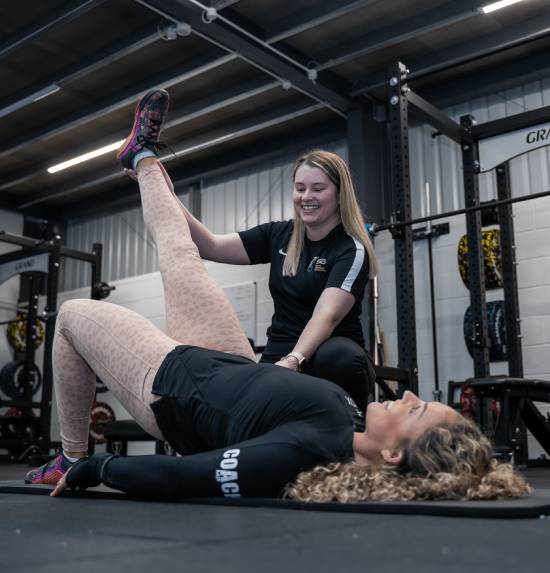Our Leeds clinic Sports Therapist, Rachael Harris, recently completed her masters in MSc Sport & Exercise Medicine from Leeds Beckett University. Here is an insight into how Rachael’s masters degree has further up-skilled Rachael’s knowledge within the field of Sport & Exercise Therapy. Below is Rachael’s Postgraduate research journey.
* * *
As many of my Leeds clients may know, I was studying for my masters degree whilst working part time in the clinic from September 2019 to November 2020. I decided to undertake a Masters in Sport & Exercise Medicine as I believed this would enhance my understanding and knowledge of the Sport and Exercise Therapy field. Studying full time for a Masters and working part time as a Sports Therapist did prove to be a challenge at some points (especially during exam periods!). But I loved my job : working in the clinic and building a relationship with clients whilst regularly seeing improvements. My passion for the job has only grown stronger whilst working and studying simultaneously.
MODULES
My Sports and Exercise Medicine degree consisted of six modules. Some elements of the modules were practical based in the labs whilst other aspects were theory based. These were:
- Biomechanics – the explanation of the function of the neuromuscular system and the mechanical basis of joint and muscle function.
- Clinical Decision Making in Sport – critical appraisal of research evidence and critical evaluation to help determine the variety of decision makings within practice.
- Sport Injury Management & Rehabilitation – theoretical and practical approach which develops a comprehensive understanding of injury management.
- Epidemiology & Sports Trauma Management – development of evidence based sports trauma management techniques within our scope of practice and when appropriate referral / return to play should occur.
- Physiology of Sports Performance – considering issues that would occur when assessing a variety of elite sportsmen whilst working as a sports physiologist.
- Clinical Exercise Testing & Physiology – gaining an understanding of the application of cardiopulmonary exercise testing and exercise prescription in populations with cardiovascular and pulmonary conditions.
RESEARCH
As part of my dissertation research project I focused on exploring the determinants and incidence rates of lower extremity injuries among recreational runners. This meant I investigated what the most common running injury was and how often it was sustained. The study required participants to discuss their running related injuries from the past 12 months.
Information was gathered from 192 participants with a range of running experience. The average number of weekly running sessions ran by participants was 3.6. It was reported that the maximum number of injuries sustained over a 12 month period was 7 – with 90 out of 192 participants sustaining at least 1 running injury. Furthermore, 47% of participants said they performed a warm up, whilst 53% of participants said they did not perform a warm up, highlighting how important warm ups are prior to running in order to prevent injury occurring.
The results from my study found that the most common site of injury in recreational runners was the knee – followed by the shin, then the foot.
But what does this tell us?
As much as running is a great form of exercise and is easily accessible to almost anyone and everyone, it can easily become an addictive habit. And when this happens, it can be very common for runners to up their mileage by too much too soon – resulting in an injury. The meniscus within the knee joint as a shock absorber. When the meniscus is damaged, this can lead to the feeling of the knee possibly giving way as well as pain when twisting and moving.
There is lots of other structures that can be damaged in the knee – ligaments, cartilage, and tendons. The reason for the knee becoming the most common site of injury in the lower extremity for runners is because the ground reaction force at the centre of pressure has been found to increase up to 250% of the runners body weight. This means every time you place your foot down you are placing an excessive amount of weight through the feet alone.

Research into sporting injuries can help us understand how to prevent further injuries from occurring.
If you have any further questions regarding this topic or anything else, head over to our contact page – here.

